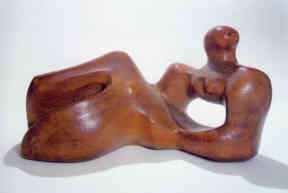



(1898- )
Moore's interest in non-Western sculpture led him to experiment with forms drawn from sources as varied as Sumerian and pre-Columbian artifacts, in addition to natural formations such as pehhles, rocks, and hones His audacious address to new sculptural problems such as the inclusion of negative, or empty, spaces, as part of the whole, won him a singular position in the British avant-garde, and, during the 1940s, international acclaim Most contemporary British sculptors of younger generations
MOORE'S THOUGHTS ON ART
"The human figure is what interests me most deeply, but I have found principles of form and
rhythm from the study of natural objects such as pebbles, rocks, bones, trees, shells, etc. Pebbles and rocks show nature's way of working stone. Smooth, sea-worn pebbles show the wearing away, rubbed treatment of stone and principles of asymmetry. Rocks show the hacked, hewn treatment of stone, and have a jagged nervous block rhythm. Bones have marvelous structural strength and hard tenseness of form, subtle transition of one shape into the next and great variety in section. Trees (tree trunks) show principles of growth and strength of joints, with easy passing of one section into the next. They give the ideal for wood sculpture, upward twisting movement. Shells show nature's hard but hollow form (metal sculpture) and have a wonderful completeness of single shape. My aim in work is to combine, as intensely as possible, the abstract principles of sculpture along with the realization of my idea. Abstract qualities of design are essential to the value of a work, but to me of equal importance is the psychological, human element. If both abstract and human elements are welded together in a work, it must have a fuller,deeper meaning." [1934
"A piece of stone can have a hole through it and not be weakened-if the hole is of a studied size, shape, and direction. On the principle of the arch, it can remain just as strong.
The first hole though a piece of stone is a revelation.
The hole connects one side to the other, making it immediately more three-dimensional.
A hole can itself have as much shape~meaning as a solid mass.
The mystery of the hole-the mvsterious fascination of caves in hillsides and cliffs." [1937]"The most striking quality common to all primitive art is its intense vitality. It is something made I)y people with a direct and immediate response to life. Sculpture and painting for them was not an activity of calculation or academism, but a channel for expressing powerful beliefs, hopes, and fears. It is art before it got smothered in trimmings and surface decorations, before inspiration had flagged into technical tricks and intellectual conceits. But apart from its own enduring value, a knowledge of it conditions a fuller and truer appreciation of the later developments of the so~called great periods, and shows art to be a universal continuous activity with no separation between past and present." (1941)